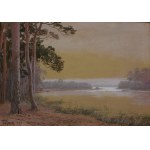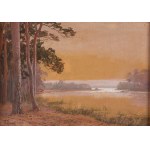akwarela, gwasz (?), papier; w św. p-p 18,5 x 26 cm; w oprawie: 44 x 60 cm
sygn., dat. l. d.: G Rosen.1924. Proweniencja: kolekcja prywatna Polska
Studiował w Petersburgu w latach 1873 - 1878, a następnie u Eugenia Dückera na
Akademii Sztuk Pięknych w Düsseldorfie. W latach 1886 - 1890 pracował w
Petersburgu a od 1901 był wykładowcą na Politechnice w Rydze. Pełnił również
funkcję dyrektora szkoły artystycznej. W 1911 uzyskał tytuł profesora. W latach ’20
XXw przeniósł się do Niemiec. Tworzył pejzaże inspirowane krajobrazami krajów
bałtyckich i północnej Europy. W jego malarstwie widoczne są wpływy akademickiego
realizmu, połączone z subtelnym studium światła i atmosfery. W swoich obrazach
podejmował tematykę leśną, nadmorską i wiejską, dokumentując zarazem charakter
północnego pejzażu.
Brał udział w wielu wystawach między innymi w Petersburgu, Rydze i Düsseldorfie.
Jego prace znajdują się w zbiorach muzealnych w Rydze, Tartu czy Düsseldorfie.
Twórczość Rosena stanowi ważne świadectwo malarstwa pejzażowego przełomu
XIX i XX wieku, a jego działalność pedagogiczna miała duże znaczenie dla rozwoju
środowiska artystycznego w Rydze i krajach bałtyckich.
He studied in St. Petersburg between 1873 and 1878, and later with Eugen Dücker at the Düsseldorf Academy of Fine Arts. From 1886 to 1890 he worked in St. Petersburg, and from 1901 taught at the Polytechnic in Riga, where he also served as director of the art school. In 1911 he was granted the title of professor, and in the 1920s moved to Germany.
He painted landscapes inspired by the scenery of the Baltic region and Northern Europe, combining academic realism with a subtle study of light and atmosphere. His works feature forest, coastal, and rural themes, reflecting the distinctive character of the northern landscape.
He exhibited in St. Petersburg, Riga, and Düsseldorf, and his works are held in museum collections in Riga, Tartu, and Düsseldorf. Rosen’s oeuvre represents an important contribution to turn-of-the-century landscape painting, and his teaching played a significant role in shaping the artistic life of Riga and the Baltic countries.













